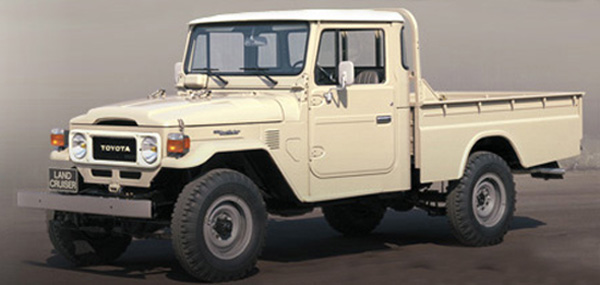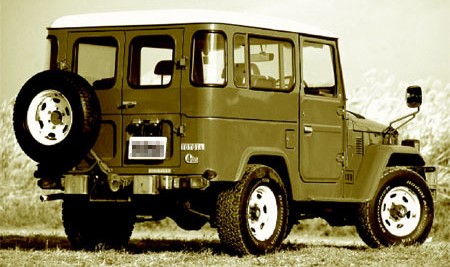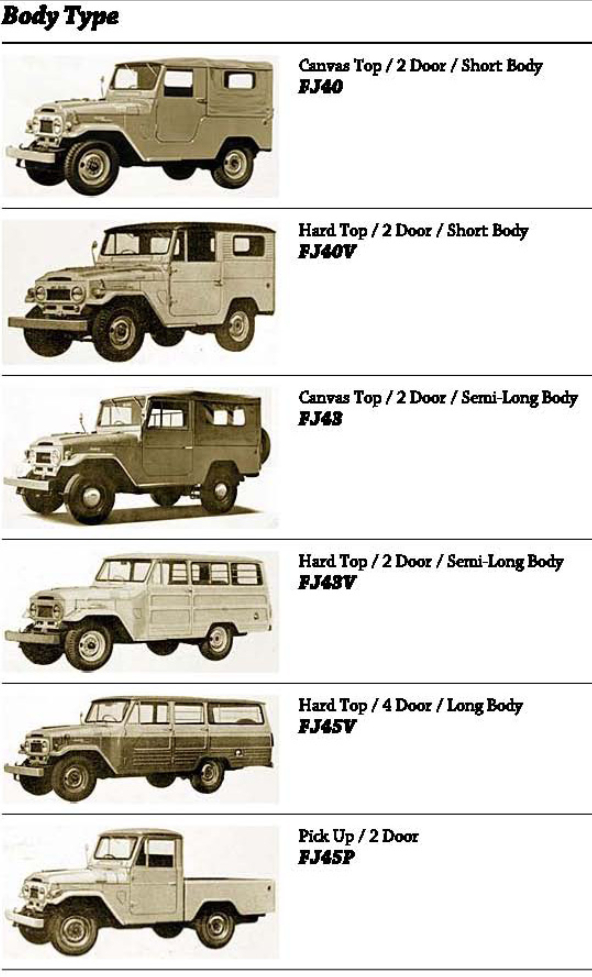
Although looking almost the same on the outside, the 20 and 40-series differed a lot on the inside. In addition, defying the eye, the construction of the body was vastly different. The 40-series, with a similar exterior vibe throughout, since expanded its range with approximately 25 years of accumulated technology advances.
With the appearance of the FJ20 series the reputation of the Land Cruiser was secure, especially in foreign markets. From this point on it was a matter of pursuing higher output, better performance, and making improvements and refinements throughout. After this Toyota also put greater attention on development of passenger cars, and with the completion of the Crown, from 1958 began exporting cars to the United States.
In 1960 the FJ-type took an evolutionary step into the 40-series. Though there was very little change in the external appearance of the vehicle, production techniques were modernized with the introduction of large-scale press equipment, and changes were made in processes, such as the way panels were assembled. Moreover, a LO range subgear was added to the transfer, which improved both acceleration and performance on bad roads. In addition, with the 2-speed transfer lever moved to the instrument panel and the 3-speed shift lever moved to the steering column, this made floor room so that 3 people could sit in the front. The design was so well received that few changes were made, and the first major structural development wasn’t seen until the 40-series. Whereas the 20-series F-type engine had an output of 105HP, by the FJ40 the engine had an output of 125HP, which eventually was boosted to 130HP, at least for the domestic market.
The 40-series lineup included the short wheelbase FJ40 (soft top and light van model), the middle wheelbase FJ43, and the long wheelbase FJ45. The FJ28 had 3 variations, a soft top, hard top, and light van model. The FJ43 came in only 2 variations, a soft top and a hard top model. The FJ45V was a van type, and there was also a pickup truck model made for export.
The FJ40V was styled as a top-heavy box-like extension of the paneling on the soft top type. To reduce the added weight resinous materials were used for the roof instead of steel paneling, and the reason for raising the roof so high was for improved visibility, with a window added to the rear corner section. The unique styling had a following and was popular.
In 1967 the market demand seriously increased for station wagons, and the FJ45V was replaced with a new FJ55V that had a wheelbase of 2,700mm.
In 1974 the BJ series debuted, which put a B-type diesel engine in the 40-series. At the time a 2.8-liter piston displacement was thought of as the upper limit for a 4-cylinder diesel engine, but the B-type extended the piston capacity to 3.0-liters, and was developed for installation in the 2-ton trucks like the Dyna and the Coaster. As a result the weight in the domestic market shifted from the FJ to the BJ in the 40-series. Moreover, from 1967 a model was produced for export that was equipped with an H-type 6-cylinder 3,576cc diesel engine.
The appearance of the BJ40 series was epoch-making for the Japanese domestic 4×4 market. Before that the FJ 4-liter gasoline engine had been classified in the Japanese vehicle registration system as a large vehicle, making it more expensive to maintain and a heavy tax liability for individuals to own. However, with the diesel engine it became reclassified as a compact vehicle, making it easier for individual users to own. Moreover, the F-type engine underwent improvements in the same year, and the FJ56V made its debut with the new 4.2-liter 2F-type engine.
Drawing the curtain on a 24-year history as a long seller in Japan, the 40-series was followed by the debut of the 70-series. During this time there were few changes made in the external appearance of the vehicle, but it was continually improved from within. In particular, from the late 1960s to early 1970s, when attention was increasingly focused on automotive air pollution and manufacturing defects, Toyota put great efforts into addressing these problems.
The 40-series was an extension of the 20-series short with the 25 becoming the 40, and the longer wheelbase 28 model becoming the 43. In the later stages of the 20-series a long bodied 35 becoming the 45.
Thereby the 40-series inherited by body and chassis from the 20-series, and most of the changes focused on the power train. The 40-series for the first time took on a 2-speed transfer with a LO range, so in addition to being able to switch from 2WD to 4WD, now you were also able to switch from HI to LO range. On the 40-series the switch from 2WD to 4WD was made by engaging or disengaging the front wheel drive using an engine vacuum actuator; whereas the HI/LO switch was a remote control type by the mechanical operation of a lever. To switch from the 2WD to the higher 4WD range you pulled a knob, and to switch into the LO range you operated the lever. It was built in such a way that moving the lever automatically triggered the switch in a single smooth operation.
The change to a 2-speed transfer was also linked to the change to a 3-speed transmission. The 20-series did not have a LO range, so it required a 4-speed transmission, but with the 40-series the gear ratio adapted to very low speeds reduced the need for an extra gear in the transmission. The operational interaction of the transfer and the transmission also underwent changes that led to increased reliability of operation. The front drive switch knob remained on the instrument panel, but the HI/LO switch was moved to a floor shift type directly on the transfer. By that time changes in the transmission reflected a shift to the 4-speed and 5 speed.
The F-type gasoline engine was switched to a B-type diesel engine, with improvements in the piston displacement, and other accommodations to increasingly strict emissions control regulations. The 3.0-liter engine that had been found in the BJ40/43 was enlarged to a 3.2-liter power unit, and this B-type engine was put in the BJ41/44. Then an even larger 3.4-liter 3B-type engine, which cleared increasingly strict emissions regulations, was mounted in the BJ44/46.

The Toyota FJ40 is the model designation for a Toyota Land Cruiser 40 series made from 1960 until 1984. Most 40 series Land Cruisers were built as two-door vehicles with slightly larger dimensions than a Jeep
The BJ42V was the last short wheelbase model in the 40-series. Shown in the photograph is the top of the line luxury LX grade model, which not only had a softer ride with softer springs, and improvements in emissions with the 3B-type diesel engine. It also came with a 5-speed M/T and power steering as standard equipment, which made it easier to travel long distances.
On the upper grade LX of the BJ42 the dashboard panel had a crash pad to protect passengers in the event of a collision, as well as a switch panel board for cosmetic effect, a digital clock, and a tachometer. The M/T and transfer shift levers had already both been moved to the floor when the change was made from the FJ to the BJ, and there were no changes made to the drive train mechanisms.
The LX grade of the latest model BJ42/BJ46 had resinous paneling on the walls, and carpeting on the floors. The springs were set soft, which made for a softer ride. The 40-series retained the tough image, but also added some features of the passenger car.
The early model FJ engine specs were a maximum output of 125ps/3,600rpm, and a maximum torque of 29.0kgm/2,000rpm, which later was upgraded to 130ps/3,600rpm and 30.0kgm/2,200rpm.
The front springs were made of 7 plates, each 70mm wide and 6mm thick. The rear springs were made of 6 plates, each 70mm wide and 7mm thick, reinforced by an 11mm helper leaf to be able to bear heavier loads. These were the same specs as on the long wheelbase FJ45V.
The 3B-type diesel engine in the BJ42/BJ46 had a larger bore than the 2B-type engine that had been used in the predecessor BJ41/BJ44, and it had a piston displacement of 3,431cc. The engine room for the 6-cylinder F-type engine was too wide for the 4-cylinder 3B engine. The cylindrically shaped part in front of the passenger seat is the heater unit, which drew air in from a slitted panel behind the front fender.


You must be logged in to post a comment.